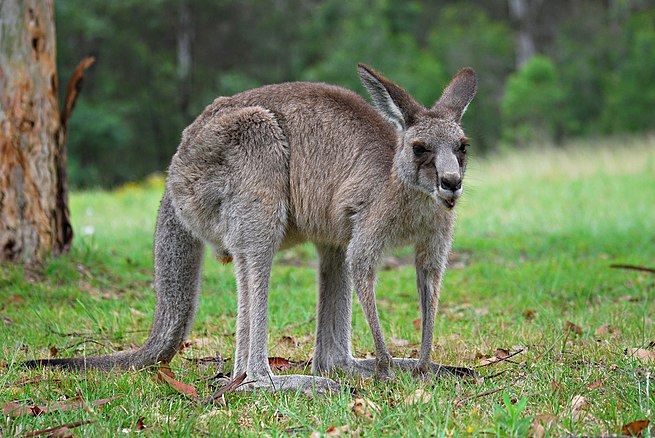
Main Difference
The main difference between Kangaroo and Wallaby is that the Kangaroo is a сommon name of family of marsupials and Wallaby is a common name of small- or mid-sized macropods found in Australia and New Guinea.
-
Kangaroo
The kangaroo is a marsupial from the family Macropodidae (macropods, meaning “large foot”). In common use the term is used to describe the largest species from this family, especially those of the genus Macropus: the red kangaroo, antilopine kangaroo, eastern grey kangaroo, and western grey kangaroo. Kangaroos are indigenous to Australia. The Australian government estimates that 34.3 million kangaroos lived within the commercial harvest areas of Australia in 2011, up from 25.1 million one year earlier.As with the terms “wallaroo” and “wallaby”, “kangaroo” refers to a paraphyletic grouping of species. All three refer to members of the same taxonomic family, Macropodidae, and are distinguished according to size. The largest species in the family are called “kangaroos” and the smallest are generally called “wallabies”. The term “wallaroos” refers to species of an intermediate size. There is also the tree-kangaroo, another genus of macropod, which inhabits the tropical rainforests of New Guinea, far northeastern Queensland and some of the islands in the region. A general idea of the relative size of these informal terms could be:
wallabies: head and body length of 45–105 cm and tail length of 33–75 cm; The dwarf wallaby (the smallest member) is 46 cm long and weighs 1.6 kg;
tree-kangaroos: from Lumholtz’s tree-kangaroo body and head length of 48–65 cm, tail of 60–74 cm, weight of 7.2 kg (16 lb) for males and 5.9 kg (13 lb) for females; to the grizzled tree-kangaroo length of 75–90 cm (30 to 35 in) and weight of 8–15 kg (18–33 lb);
wallaroos: the black wallaroo, the smallest by far, with a tail length of 60–70 cm and weight of 19–22 kg for males and 13 kg for females;
kangaroos: a large male can be 2 m (6 ft 7 in) tall and weighs 90 kg (200 lb).Kangaroos have large, powerful hind legs, large feet adapted for leaping, a long muscular tail for balance, and a small head. Like most marsupials, female kangaroos have a pouch called a marsupium in which joeys complete postnatal development.
The large kangaroos have adapted much better than the smaller macropods to land clearing for pastoral agriculture and habitat changes brought to the Australian landscape by humans. Many of the smaller species are rare and endangered, while kangaroos are relatively plentiful.
The kangaroo is a symbol of Australia and appears on the Australian coat of arms and on some of its currency and is used by some of Australia’s well known organisations, including Qantas and the Royal Australian Air Force. The kangaroo is important to both Australian culture and the national image, and consequently there are numerous popular culture references.
Wild kangaroos are shot for meat, leather hides, and to protect grazing land. Although controversial, kangaroo meat has perceived health benefits for human consumption compared with traditional meats due to the low level of fat on kangaroos.
-
Wallaby
A wallaby is a small- or mid-sized macropod native to Australia and New Guinea, with introduced populations in New Zealand, UK and other countries. They belong to the same taxonomic family as kangaroos and sometimes the same genus, but kangaroos are specifically categorised into the six largest species of the family. The term wallaby is an informal designation generally used for any macropod that is smaller than a kangaroo or wallaroo that has not been designated otherwise.There are 11 species of brush wallabies (g. Macropus, s.g. Protemnodon). Their head and body length is 45 to 105 cm and the tail is 33 to 75 cm long. The six named species of rock-wallabies (g. Petrogale) live among rocks, usually near water; two species are endangered. The two species of hare-wallabies (g. Lagorchestes) are small animals that have the movements and some of the habits of hares. Often called “pademelons”, the three species of scrub wallabies (g. Thylogale) of New Guinea, the Bismarck Archipelago, and Tasmania are small and stocky, with short hind limbs and pointed noses.
Wallabies are hunted for meat and fur. A similar species is the short-tailed scrub wallaby, or quokka (Setonix brachyurus); this species is now restricted to two offshore islands of Western Australia. The three named species of forest wallabies (g. Dorcopsulus) are native to the island of New Guinea. The dwarf wallaby is the smallest member of the genus and the smallest known member of the kangaroo family. Its length is about 46 cm from nose to tail, and it weighs about 1.6 kg.
-
Kangaroo (noun)
A member of the Macropodidae family of large marsupials with strong hind legs for hopping, native to Australia. from 18th c.
-
Kangaroo (noun)
A hooded jacket with a front pocket, usually of fleece material, a kangaroo jacket.
-
Kangaroo (verb)
To practice kangaroo care on an infant; to hold a premature infant against the skin.
-
Kangaroo (verb)
To hunt kangaroo.
-
Kangaroo (verb)
To move like a kangaroo
-
Wallaby (noun)
Any of several species of marsupial; usually smaller and stockier than kangaroos
-
Wallaby (noun)
an Australasian marsupial that is similar to, but smaller than, a kangaroo.
-
Wallaby (noun)
the Australian international rugby union team.
